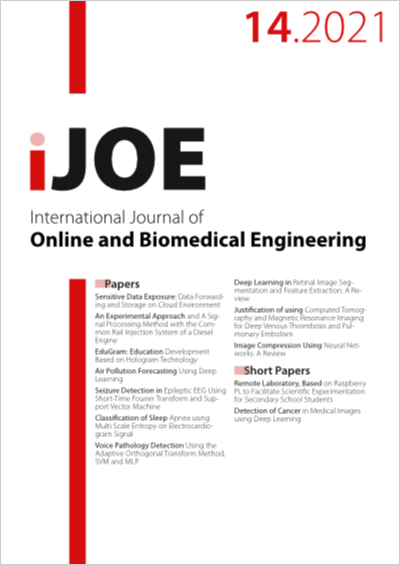EduGram: Education Development Based on Hologram Technology
DOI:
https://doi.org/10.3991/ijoe.v17i14.27371Keywords:
Hologram, Education, Augmented Reality, Three-dimensional image, 3D Hologram Fan.Abstract
Education is one of the most important areas of life that affect the development and progress of societies, and the usage of images and visual representation methods is of real value in the educating process. Over time, different simple methods were used to display the information visually, which mostly are considered weak methods that may not perform its full purpose and the information may be transferred slowly and in an incomplete manner. Technology has contributed from the beginning of its emergence in the development of education and improve its output, and one of the most prominent contributions made by technology is the developments in the field of displaying information visually using different technologies, as the three-dimensional displaying technologies that are considered as an advanced solution which provides people with a more comprehensive view and facilitates the task of transferring information to learners and so improving the educating process. Many technologies are used to create and display the 3D visual content, and two of the most important 3D display technologies are Augmented Reality technology and Hologram technology, they both insert a three-dimensional image to the real world, but there are many differences between the two technologies in many aspects. In the first part of this research, and after defining and comparing the two technologies and the effect of each one on education, Hologram technology showed features that enabled it to be a suitable option to be used in education for displaying 3D educational content. This research then introduces the method for implementing the usage of Hologram technology in education as a 3D educational content displaying tool, introducing an implementation model by first transferring a sample of a 2D educational image to Holograms and using the Hologram fan projector to display it to the students. The results of a simple questionnaire on a number of people showed the effectiveness of using Holograms instead of the traditional 2D content found in school curricula, and a good level of people's acceptance to use this technology.
Downloads
Published
2021-12-14
How to Cite
Ahmad, A. S., Alomaier, A. T., Elmahal, D. M., Abdlfatah, R. F., & Ibrahim, D. M. (2021). EduGram: Education Development Based on Hologram Technology. International Journal of Online and Biomedical Engineering (iJOE), 17(14), pp. 32–49. https://doi.org/10.3991/ijoe.v17i14.27371
Issue
Section
Papers
License
Copyright (c) 2021 Asma S. Ahmad, Alaa T. Alomaier, Doaa M. Elmahal, Reem F. Abdlfatah, Dina M. Ibrahim

This work is licensed under a Creative Commons Attribution 4.0 International License.



